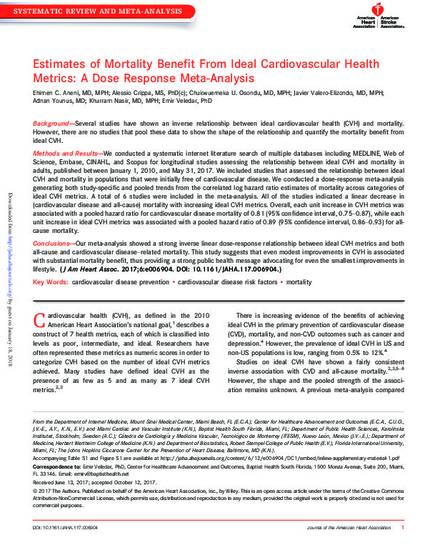
Background Several studies have shown an inverse relationship between ideal cardiovascular health (CVH) and mortality. However, there are no studies that pool these data to show the shape of the relationship and quantify the mortality benefit from ideal CVH.
Methods and Results We conducted a systematic internet literature search of multiple databases including MEDLINE, Web of Science, Embase, CINAHL, and Scopus for longitudinal studies assessing the relationship between ideal CVH and mortality in adults, published between January 1, 2010, and May 31, 2017. We included studies that assessed the relationship between ideal CVH and mortality in populations that were initially free of cardiovascular disease. We conducted a dose‐response meta‐analysis generating both study‐specific and pooled trends from the correlated log hazard ratio estimates of mortality across categories of ideal CVH metrics. A total of 6 studies were included in the meta‐analysis. All of the studies indicated a linear decrease in (cardiovascular disease and all‐cause) mortality with increasing ideal CVH metrics. Overall, each unit increase in CVH metrics was associated with a pooled hazard ratio for cardiovascular disease mortality of 0.81 (95% confidence interval, 0.75–0.87), while each unit increase in ideal CVH metrics was associated with a pooled hazard ratio of 0.89 (95% confidence interval, 0.86–0.93) for all‐cause mortality.
Conclusions Our meta‐analysis showed a strong inverse linear dose‐response relationship between ideal CVH metrics and both all‐cause and cardiovascular disease–related mortality. This study suggests that even modest improvements in CVH is associated with substantial mortality benefit, thus providing a strong public health message advocating for even the smallest improvements in lifestyle.
Available at: http://works.bepress.com/emir-veledar/27/

Originally published in Journal of the American Heart Association.